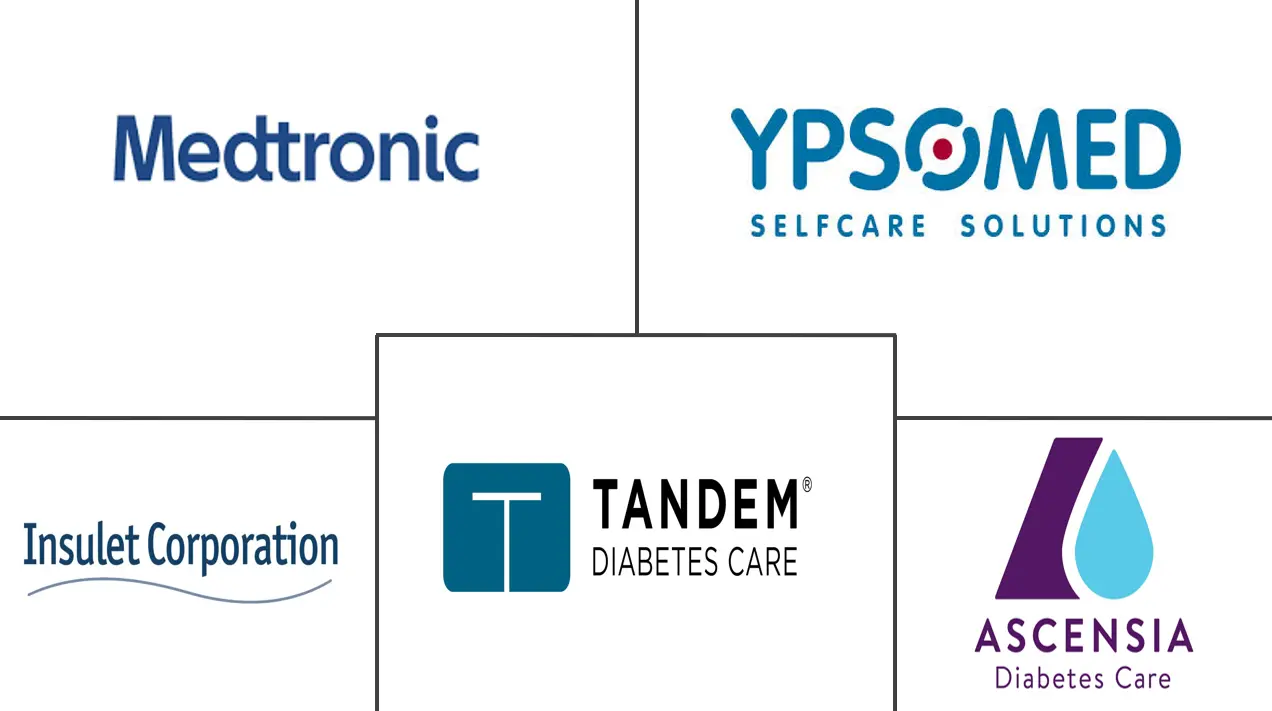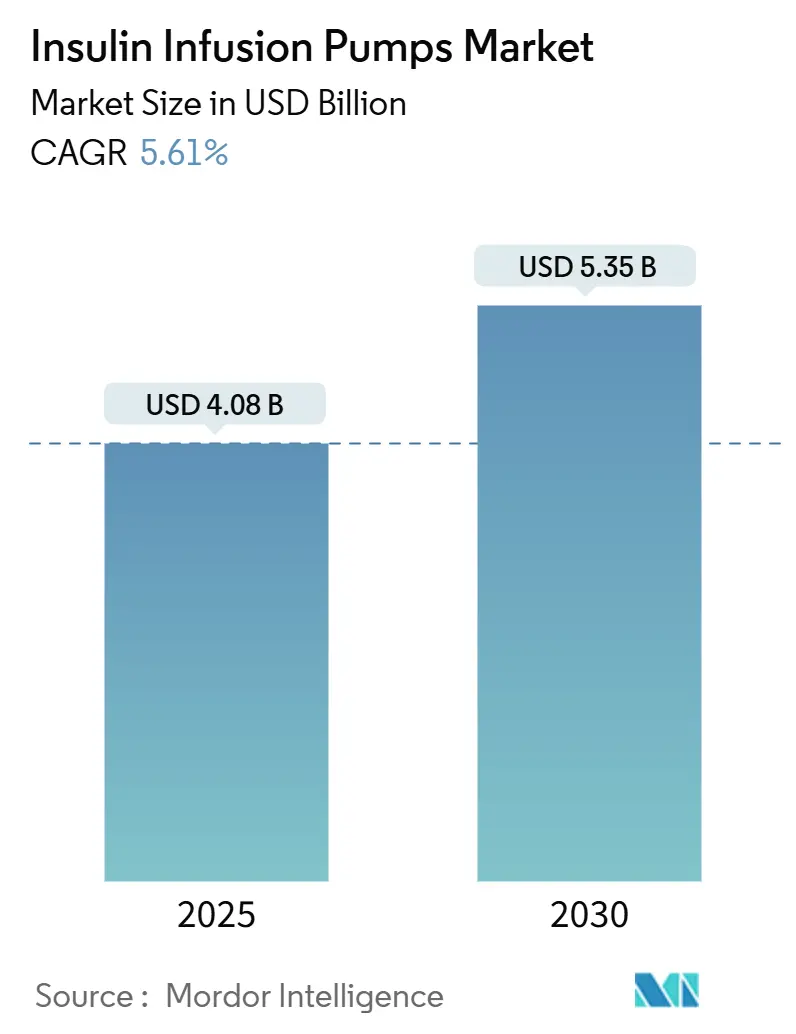
Insulin Infusion Pumps Market Analysis by Mordor Intelligence
The Insulin Infusion Pumps Market size is estimated at USD 4.08 billion in 2025, and is expected to reach USD 5.35 billion by 2030, at a CAGR of 5.61% during the forecast period (2025-2030).
Sustained demand arises from the convergence of continuous glucose monitoring with automated insulin delivery, the transition from tethered to closed-loop platforms, and broader adoption among Type 2 diabetes patients. Patch pumps and hybrid closed-loop systems now set performance benchmarks, while reimbursement expansion and pediatric approvals enlarge the user base. Cybersecurity vigilance, supply-chain pressures, and regulatory complexity continue to temper growth, yet the insulin infusion pumps market remains pivotal to global diabetes management.
Key Report Takeaways
- By component, insulin pump devices led with 65.73% revenue share in 2024; reservoirs are projected to expand at an 8.01% CAGR through 2030.
- By pump type, patch pumps held 52.61% of the insulin infusion pumps market share in 2024, while the segment accelerates at an 8.74% CAGR to 2030.
- By patient type, Type 2 diabetes accounted for 67.12% share of the insulin infusion pumps market size in 2024 and is advancing at a 10.07% CAGR through 2030.
- By end user, homecare settings captured 56.37% share in 2024 and represent the fastest growth at a 9.27% CAGR to 2030.
- By geography, North America held 37.32% share in 2024, whereas Asia-Pacific is expanding at a 7.07% CAGR through 2030.
Global Insulin Infusion Pumps Market Trends and Insights
Drivers Impact Analysis
| Driver | (~) % Impact on CAGR Forecast | Geographic Relevance | Impact Timeline |
|---|---|---|---|
| Rapid Adoption of Closed-Loop "Artificial Pancreas" Systems | +1.8% | Global, with North America and Europe leading | Medium term (2-4 years) |
| Rising Prevalence of Type 1 Diabetes in Youth | +1.2% | Global, with highest impact in developed markets | Long term (≥ 4 years) |
| Reimbursement Expansion for Tubeless Pumps | +0.9% | North America, Europe, select APAC markets | Short term (≤ 2 years) |
| Growth of the DIY Looping Community | +0.5% | Global, concentrated in tech-savvy demographics | Medium term (2-4 years) |
| Bluetooth-Enabled Analytics and Mobile Integration | +0.7% | Global | Short term (≤ 2 years) |
| Inclusion in Corporate Wellness Programs | +0.4% | North America, Europe | Medium term (2-4 years) |
| Source: Mordor Intelligence | |||
Rapid Adoption of Closed-Loop “Artificial Pancreas” Systems
FDA approval of Medtronic’s MiniMed 780G in April 2025 underscored the value of automated meal detection and five-minute insulin adjustments, pushing time-in-range figures above 70% among large user cohorts. Tandem’s Control-IQ platform shows comparable benefits, highlighting a technology race that rewards algorithm accuracy and sensor reliability. Artificial intelligence enables dose personalization that mimics physiologic insulin patterns, positioning closed-loop platforms as the future standard of care. Growing clinical proof amplifies payer confidence and broadens eligibility criteria. As marketing emphasizes lifestyle simplicity instead of device mechanics, patient receptivity rises, driving incremental units and recurring consumable sales.
Rising Prevalence of Type 1 Diabetes in Youth
Incidence rates among children now exceed 3.5 per 1,000 in the United States, with similar uptrends in Europe and parts of Asia.[1]JAMA Network, “Incidence of Type 1 Diabetes in US Youth,” jamanetwork.com Pediatric societies recommend pump therapy as first-line treatment, citing superior glycemic control and reduced nocturnal hypoglycemia.[2]International Society for Pediatric and Adolescent Diabetes, “Clinical Practice Guidelines 2024,” ispad.org FDA clearance of automated insulin delivery for ages two and above widens the pediatric addressable pool. Regional registries reveal adoption gaps, suggesting unmet demand where clinical support lags. Manufacturers respond with smaller reservoirs, simplified user interfaces, and colorful patch adhesives that resonate with younger users and caregivers.
Reimbursement Expansion for Tubeless Pumps
Medicare’s 2023 coinsurance cap and the Senior Savings Model materially lowered monthly insulin costs for pump users.[3]Centers for Medicare & Medicaid Services, “Insulin and the Senior Savings Model,” cms.gov Commercial formularies have catalogued patch pumps as preferred options, citing total-cost-of-care reductions from fewer emergency visits and hospitalizations. Several state Medicaid programs now bypass historic three-year replacement rules, accelerating upgrade cycles. Payer alignment on value-based outcomes creates predictable revenue streams for suppliers while mitigating patient expense anxiety. Broader coverage has a cascading impact on clinician prescribing habits, cementing tubeless technology in routine practice.
Rising Adoption of DIY Looping Systems
Open-source algorithms gave early proof that fully automated insulin delivery could be achieved with repurposed pumps and consumer electronics. These grass-roots experiments pressured commercial vendors to speed closed-loop launches and adopt interoperable architecture. Regulatory acknowledgment of patient-driven innovation, reflected in FDA guidance documents, legitimizes collaboration between citizen developers and device makers. The DIY ethos also fosters inclusive language, user-friendly dashboards, and frequent software updates all of which shape product roadmaps. While home-built systems are not broadly reimbursed, their influence on design expectations remains profound.
Restraints Impact Analysis
| Restraint | (~) % Impact on CAGR Forecast | Geographic Relevance | Impact Timeline |
|---|---|---|---|
| Cybersecurity Risks in Connected Devices | -0.8% | Global, with heightened concern in developed markets | Short term (≤ 2 years) |
| High Out-of-Pocket Costs in Emerging Markets | -1.1% | APAC, Latin America, Middle East & Africa | Long term (≥ 4 years) |
| Supply Chain Disruptions for Sterile Tubing and Components | -0.6% | Global | Medium term (2-4 years) |
| Regulatory Delays for Next-Gen Devices | -0.4% | Global, with varying impact by region | Medium term (2-4 years) |
| Source: Mordor Intelligence | |||
Cybersecurity Risks in Connected Devices
In 2024 the FDA flagged vulnerabilities in certain wireless pumps that could allow unauthorized access and unintended insulin delivery, prompting multiple Class I recalls. Academic analyses have since documented potential exploit pathways via unsecured Bluetooth channels, underscoring the need for end-to-end encryption and tamper-proof firmware. New FDA premarket guidance requires threat-mitigation plans and postmarket monitoring, adding development cost and elongating approval timelines. Hospitals now press suppliers for detailed cybersecurity certifications before procurement. Although no catastrophic patient harm has been reported publicly, lingering risk perception may slow adoption among risk-averse payers.
High Out-of-Pocket Costs in Emerging Markets
Insurance penetration for durable diabetes technologies remains limited in large parts of Asia, Latin America, and Africa. Surveys reveal that many patients ration insulin and test strips, leaving little disposable income for premium pump hardware. Adoption sits below 5% in some high-burden countries, despite clear clinical gains among users. Manufacturers that wish to tap these markets must tailor price points and financing terms while advocating for broader public reimbursement. Without systemic funding solutions, the insulin infusion pumps market will struggle to fulfill its preventive potential in regions where diabetes prevalence rises fastest.
Segment Analysis
By Component: Devices Anchor Revenue While Reservoirs Accelerate Growth
Insulin pump devices retained 65.73% of 2024 revenue, underscoring their premium pricing and embedded software complexity. Consumable reservoirs, however, expanded faster at an 8.01% CAGR as hybrid closed-loop algorithms modulated insulin micro-boluses more frequently. Integration of smart sensors inside reservoirs to detect occlusions and air bubbles heightens patient safety and gives vendors cross-selling leverage. Strategic partnerships, such as Medtronic pairing its pumps with Abbott glucose sensors, exemplify an ecosystem approach that influences procurement.
Consumable dynamics also strengthen recurring revenue visibility. Manufacturers introduce extended-wear infusion sets aimed at seven-day site usage, reducing insertion trauma and driving brand loyalty. Competitive differentiation now hinges on frictionless cartridge loading, lower residual insulin waste, and antimicrobial linings that curb infection risk. These incremental innovations stabilize unit volume outlook, even when device replacement cycles lengthen in mature markets.
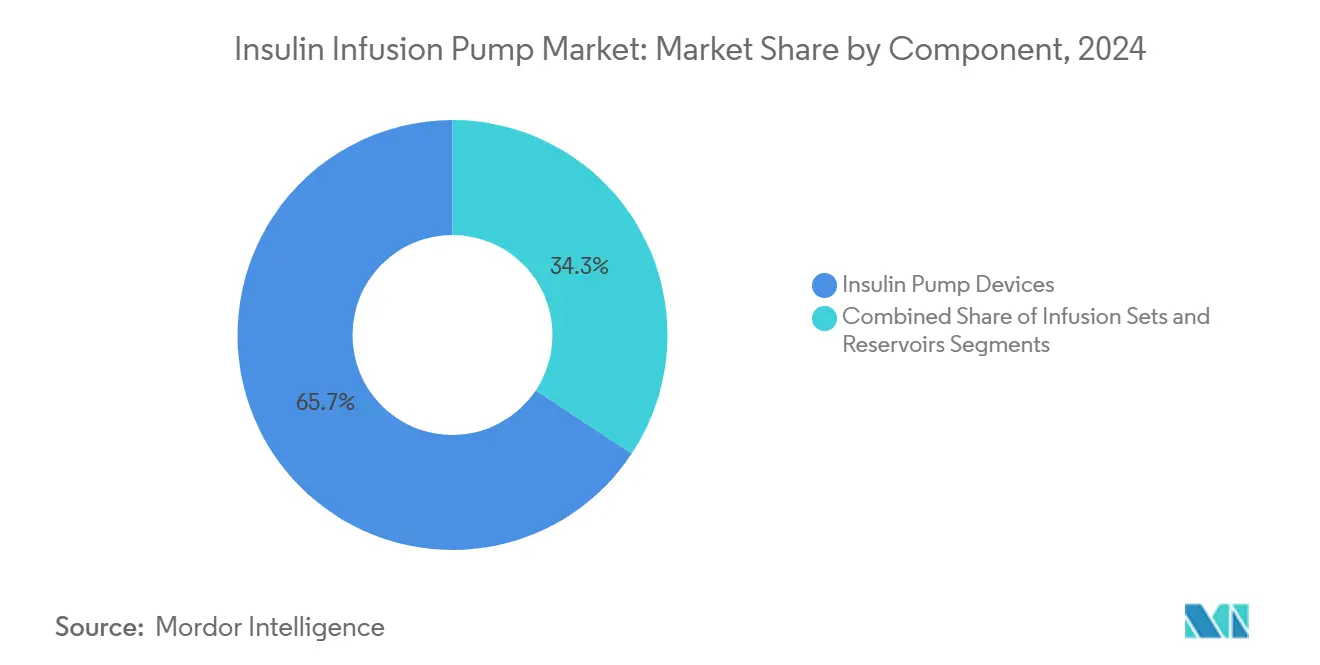
Note: Segment shares of all individual segments available upon report purchase
By Pump Type: Patch Technology Steers Market Evolution
Patch pumps captured 52.61% share in 2024 and are on track for an 8.74% CAGR, validating patient preference for tubeless, discreet wearables. Sleek industrial design, waterproof housing, and automated cannula insertion raise user comfort and minimize social stigma. Tethered pumps, while declining, still serve high-dose users who need large reservoirs or dual-hormone research protocols. Implantable systems remain experimental due to surgical hurdles.
Competition within the patch segment intensifies as Tandem’s Mobi challenges Insulet’s incumbency with a thinner profile and smartphone-only interface. Emerging entrants position low-cost patch alternatives for Asia-Pacific, bundling simplified feature sets with subscription pricing. Firmware upgrades delivered over the air enhance functionality without physical replacements, reinforcing user stickiness.
By Patient Type: Type 2 Diabetes Expansion Reshapes Demand
Type 2 diabetes patients comprised 67.12% of users in 2024 and drive the highest 10.07% CAGR, transforming the pump landscape. Evidence from the SECURE-T2D trial showed HbA1c reductions from 8.2% to 7.4% when Omnipod 5 supplanted multiple daily injections. FDA clearance of Tandem’s Control-IQ+ for adults with Type 2 diabetes validates algorithmic dosing for insulin-resistant physiology. Providers increasingly transition intensively managed patients onto pumps to relieve injection fatigue and stabilize glucose variability.
Type 1 diabetes remains foundational for early adoption of experimental features and supplies a loyal user base that advocates product refinements. Nevertheless, as prevalence growth tilts toward Type 2, device makers recalibrate messaging to emphasize ease of onboarding, limited carbohydrate logging, and telehealth-enabled coaching suited for older or comorbid populations.
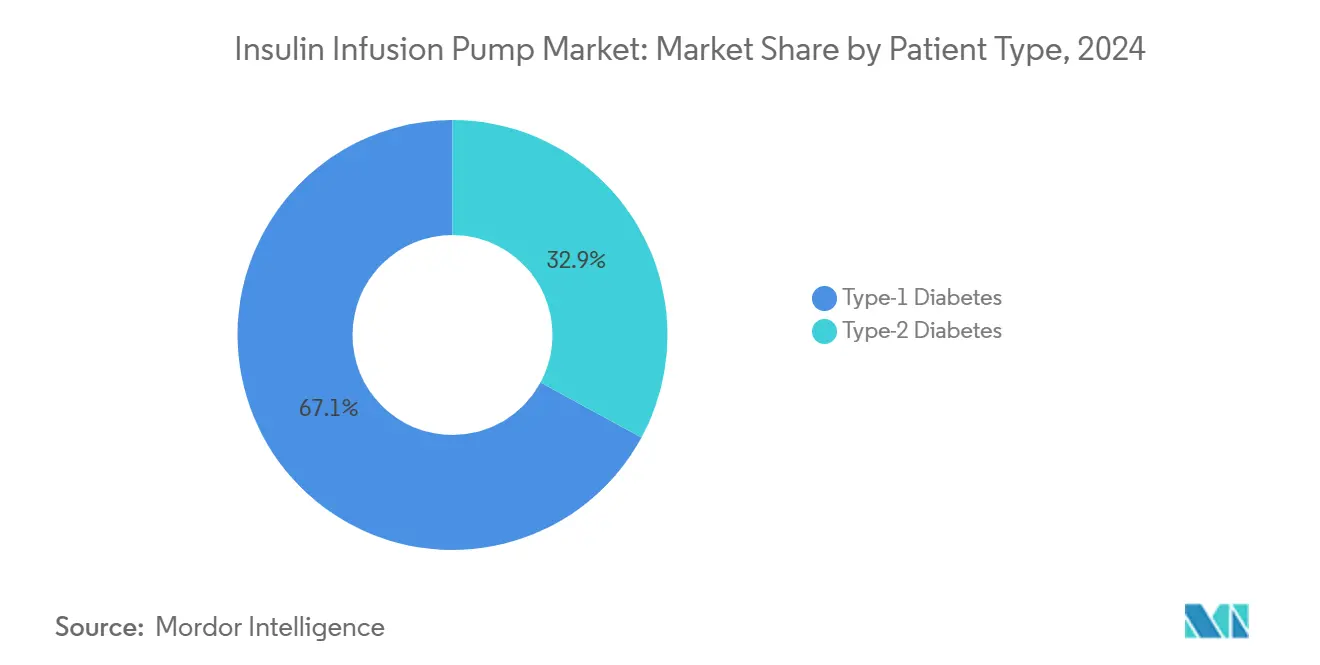
Note: Segment shares of all individual segments available upon report purchase
By End User: Homecare Settings Lead Uptake and Growth
Homecare settings generated 56.37% of revenue in 2024 and expand at a 9.27% CAGR, propelled by user-friendly mobile apps and remote patient monitoring. Telehealth growth during the COVID-19 pandemic demonstrated that most titration and troubleshooting can occur virtually, reducing the need for frequent clinic visits. Hospitals concentrate on initiation and acute troubleshooting but cede routine management to community endocrinologists and certified diabetes educators.
Ambulatory surgical centers cater to implantable and complex revision procedures, carving out a modest yet specialized niche. Integration with electronic health records enables automated data sharing, allowing multidisciplinary teams to adjust care plans without geographic constraints. As payers reimburse virtual consultations, home-based pump adoption becomes financially rational, sustaining momentum for the insulin infusion pumps market.
Geography Analysis
North America remained the largest market in 2024 with a 37.32% share, underpinned by widespread insurance coverage, advanced supply chains, and early demand from both Type 1 and Type 2 populations. The region’s mature infrastructure supports swift adoption of closed-loop upgrades and interoperable component ecosystems, though unit growth now mirrors replacement cycles more than net new users. Cybersecurity regulations also originate here, influencing global design standards.
Europe contributes steady volumes thanks to universal healthcare and robust clinical registries that benchmark outcomes. Reimbursement frameworks vary but generally favor technology proven to cut hospitalization costs. Rapid CE-mark pathways for integrated pumps and continuous glucose monitors promote competitive diversity. The Middle East and Africa lag in penetration, yet investment initiatives in Saudi Arabia and the UAE spark pilot programs that introduce patch pumps into public diabetes centers.
Asia-Pacific posts the fastest 7.07% CAGR through 2030 due to rising diabetes prevalence, urbanization, and expanding middle-class insurance pools. China’s tiered hospital system now reimburses select patch pumps for pediatric Type 1 users, while India experiments with low-cost subscription bundles for Type 2 adults. Latin America sits between growth extremes, with Brazil and Mexico leading regional adoption as private insurers pilot value-based diabetes programs. Market entrants target localized language support, hotter-climate adhesive formulations, and flexible financing to fit each region’s socioeconomic profile.
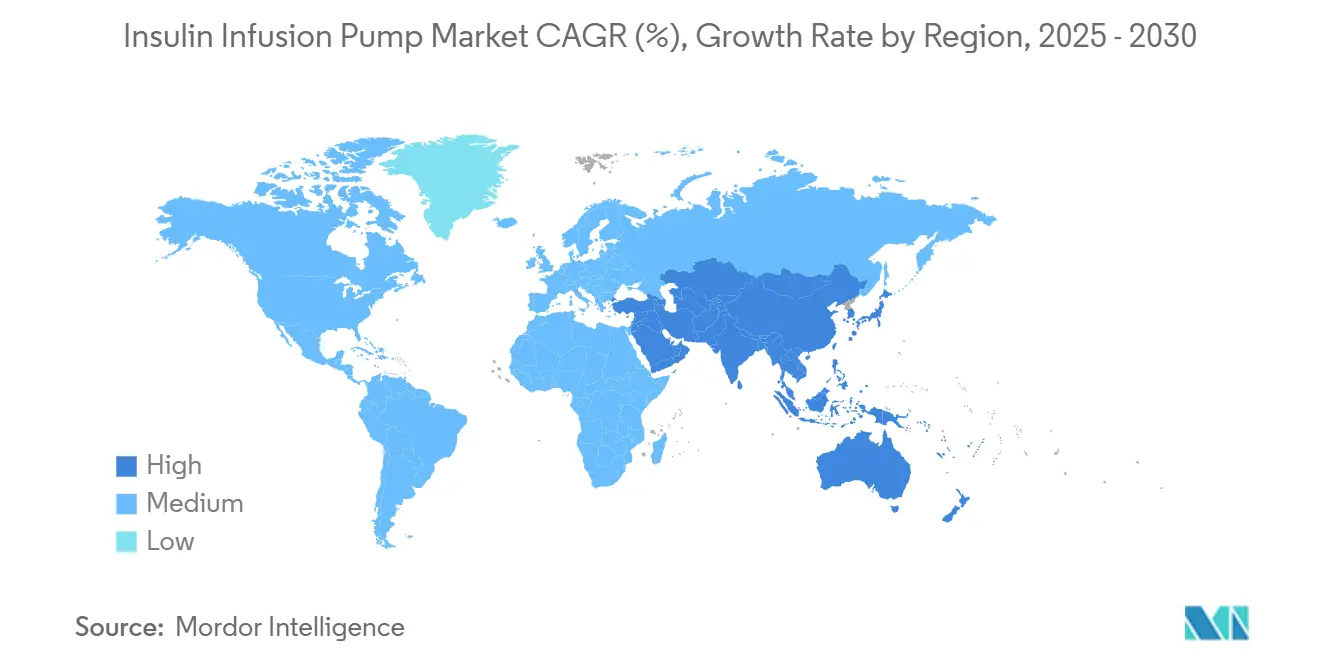
Competitive Landscape
The insulin infusion pump market demonstrates consolidation. Three vendors Medtronic, Insulet, and Tandem Diabetes Care collectively holds significant share of global revenues, establishing a moderately concentrated structure. Medtronic’s MiniMed 780G paired with the Simplera Sync CGM accounts for the largest installed base, driving Q2 FY25 diabetes revenue to USD 686 million. Insulet maintains leadership in patch pumps; its 2024 sales reached USD 2 billion on the strength of Omnipod 5 expansion into Type 2 cohorts Insulet. Tandem leverages the t:slim X2 platform and Control-IQ algorithm, reporting USD 282.6 million in Q4 2024 revenue and outlining 2025 guidance near USD 1 billion.
Emerging player Beta Bionics differentiates with the iLet Bionic Pancreas, which removes carbohydrate counting and posted 36% revenue growth in Q1 2025. Market rivalry centers on algorithm performance, mobile UX, and supply-chain resilience. Strategic moves include Medtronic’s plan to spin off its diabetes business into an autonomous company within 18 months, expected to improve capital allocation and partnership agility. Tandem and Abbott inked a 2025 pact to integrate dual glucose-ketone sensing and pump automation, aiming to reduce diabetic ketoacidosis episodes.
Component suppliers also shape competition. Adhesive innovators develop hypoallergenic patches, while sensor makers pursue factory-calibrated CGMs that shorten pump onboarding. Interoperability labeling lets niche vendors bolt their technologies onto multiple pump brands, fragmenting certain sub-segments. Despite brisk innovation, regulatory hurdles and cybersecurity expectations restrict market entry speed, reinforcing the advantage of incumbents with deep compliance experience and global service footprints.
Insulin Infusion Pumps Industry Leaders
-
Insulet Corporation
-
Tandem Diabetes Care
-
Ypsomed
-
Ascensia Diabetes Care
-
Medtronic
- *Disclaimer: Major Players sorted in no particular order
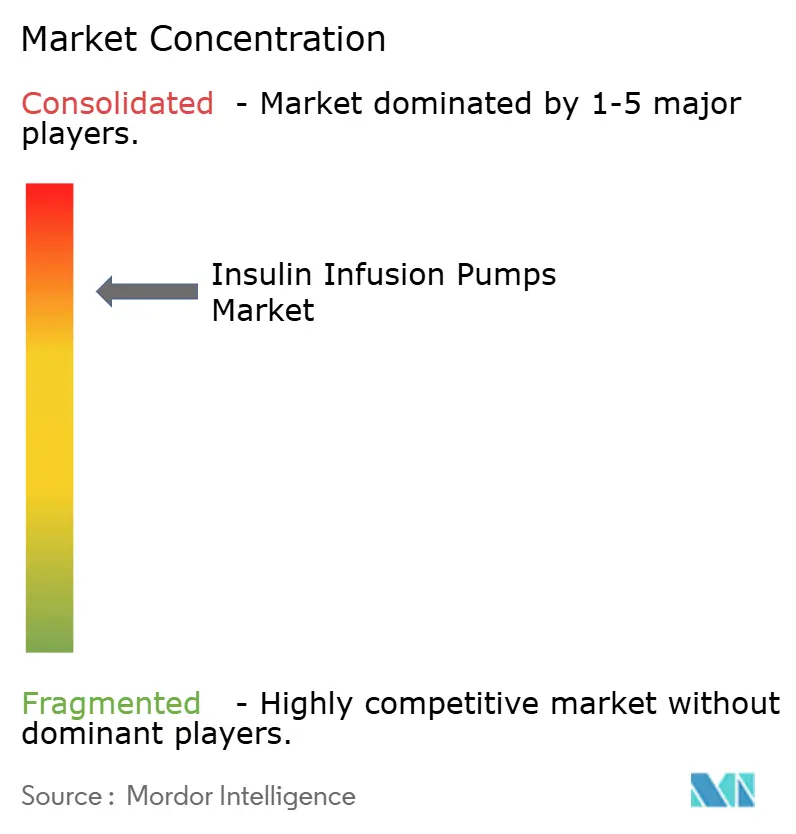
Recent Industry Developments
- June 2025: Tandem Diabetes Care announced a strategic agreement with Abbott to develop integrated diabetes solutions combining Abbott's future dual glucose-ketone sensor with Tandem's automated insulin delivery systems, aiming to prevent diabetic ketoacidosis through early ketone detection.
- May 2025: Medtronic reported strong FY25 diabetes segment performance with USD 2.755 billion revenue and announced plans to separate its diabetes business into a standalone public company within 18 months, while securing FDA approval for the Simplera Sync CGM for use with the MiniMed 780G system.
- March 2025: Tandem's t:slim X2 insulin pump received FDA clearance for use with Control-IQ+ technology in Type 2 diabetes patients aged 18 and older, expanding automated insulin delivery access beyond Type 1 diabetes.
- February 2025: Tandem Diabetes Care reported record Q4 2024 sales with worldwide revenue increasing 44% to USD 282.6 million and announced 2025 sales guidance between USD 997 million and USD 1.0 billion.
Research Methodology Framework and Report Scope
Market Definitions and Key Coverage
Our study defines the insulin infusion pumps market as all CE or FDA cleared electromechanical devices that continuously deliver basal-bolus insulin through disposable infusion sets, together with their dedicated reservoirs and tubing, supplied for human type 1 and insulin-requiring type 2 diabetes therapy worldwide.
According to Mordor Intelligence, accessories sold only for general infusion, pen injectors, software-only closed-loop algorithms, veterinary pumps, and hospital-grade multi-drug infusion systems are outside this scope.
Segmentation Overview
- By Component
- Insulin Pump Devices
- Infusion Sets
- Reservoirs
- By Pump Type
- Tethered Pumps
- Patch Pumps
- Implantable Pumps
- By Patient Type
- Type-1 Diabetes
- Type-2 Diabetes
- By End User
- Hospitals & Clinics
- Homecare Settings
- Ambulatory Surgical Centers
- By Geography
- North America
- United States
- Canada
- Mexico
- Europe
- Germany
- United Kingdom
- France
- Italy
- Spain
- Rest of Europe
- Asia-Pacific
- China
- Japan
- India
- Australia
- South Korea
- Rest of Asia-Pacific
- Middle East & Africa
- GCC
- South Africa
- Rest of Middle East & Africa
- South America
- Brazil
- Argentina
- Rest of South America
- North America
Detailed Research Methodology and Data Validation
Primary Research
Interviews with endocrinologists, certified pump trainers, distributors, and payor policy leads across North America, Europe, and key Asia-Pacific markets let us validate uptake assumptions, average selling prices, reimbursement timelines, and failure-replacement ratios, thereby closing gaps left by desk work.
Desk Research
We first built a fact base from tier-1 public datasets such as the International Diabetes Federation prevalence tables, U.S. FDA 510(k) device clearances, Eurostat trade codes for HS 90183920, and WHO Global Health Expenditure statistics, which anchor pump penetration and pricing trends across regions. Annual reports, 10-Ks, and investor decks added shipment splits, while clinical guidelines and peer-reviewed journals clarified adoption speed for patch pumps. Subscription assets, including Dow Jones Factiva for earnings calls and D&B Hoovers for private-firm revenue ranges, helped refine supplier roll-ups. This list is illustrative; many other secondary sources were also consulted for cross-checks.
Market-Sizing & Forecasting
A top-down prevalence-to-treated-cohort model converts diagnosed diabetes pools into pump candidates, applies region-specific penetration curves, and multiplies by validated ASPs to derive 2025 value. Selected bottom-up checks, manufacturer revenue roll-ups and sampled channel audits, act as guardrails. Variables fed into the model include HbA1c control targets, patch-pump share shifts, reimbursement coverage breadth, replacement cycle length, shipment seasonality, and currency movements. Five-year forecasts employ multivariate regression blended with scenario analysis, where elasticity of adoption to ASP compression and emerging closed-loop approvals form key drivers. Gaps in hard unit data are bridged through triangulated averages from at least three independent indicators before adjustment.
Data Validation & Update Cycle
Mordor analysts run variance screens against independent import data, payer claim volumes, and company guidance, flagging anomalies for senior review. Models refresh annually, with interim updates triggered by material events such as landmark regulatory approvals or large-scale tender wins, ensuring clients receive the latest vetted view.
Why Mordor's Insulin Infusion Pump Baseline Earns Trust
Published figures often diverge because firms choose different device mixes, prevalence pools, and refresh cadences. By locking scope to patient-worn insulin pumps and tying calculations to verifiable treatment cohorts, Mordor delivers a balanced baseline users can trace.
Key Gap Drivers include broader inclusion of pump consumables by some publishers, aggressive uptake curves that overlook payor prior authorization delays, and single-year currency conversions that hide FX volatility.
Benchmark comparison
| Market Size | Anonymized source | Primary gap driver |
|---|---|---|
| USD 4.08 B | Mordor Intelligence | - |
| USD 6.45 B | Global Consultancy A | Includes CGM-linked disposables and replacement sensors |
| USD 7.12 B | Industry Publisher B | Applies universal 90 % reimbursement, inflating penetration |
| USD 6.10 B | Specialist Analytics C | Uses constant 2024 FX rates, ignoring recent USD strength |
These contrasts show that when device scope, pricing reality, and currency timing are disciplined, as in Mordor's model, stakeholders gain a dependable, transparent springboard for decision-making.
Key Questions Answered in the Report
What is the current size of the insulin infusion pumps market and how fast is it growing?
The market stood at USD 4.08 billion in 2025 and is forecast to reach USD 5.35 billion by 2030, reflecting a 5.61% CAGR.
Which pump type captures the largest share of the insulin infusion pumps market?
Patch pumps dominate with 52.61% market share in 2024 and lead growth at an 8.74% CAGR through 2030.
How are Type 2 diabetes patients influencing future demand?
Type 2 diabetes users already account for 67.12% of 2024 revenue and drive the highest 10.07% CAGR as guidelines now recommend pump therapy for insulin-dependent adults.
What geographic region offers the fastest growth opportunity?
Asia-Pacific posts the quickest expansion at a 7.07% CAGR to 2030, propelled by rising diabetes prevalence and improving healthcare reimbursement.
What major risk could slow near-term adoption?
Cybersecurity vulnerabilities in connected pumps have triggered recent FDA recalls and add compliance costs that may temper short-term growth.
Page last updated on:
